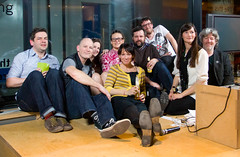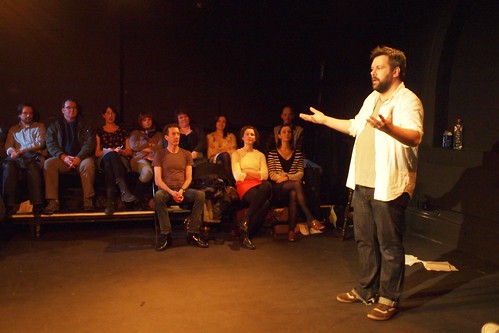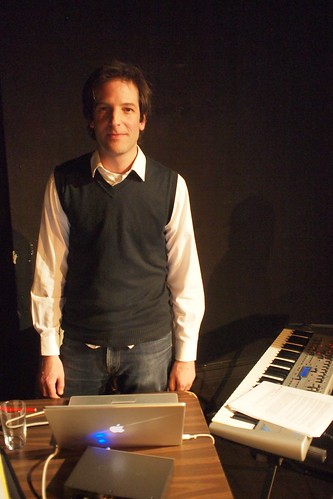I was at the Dana Centre last night delivering a
Pecha Kucha as part of
Technology You Can't Live Without, curated by the splendid
Aleks Krotoski, alongside a pretty daunting line-up of thinkers.

Our brief was to talk about a technology we can't live without and how we imagine technology developing over the next 5 years. I blithely ignored this and delivered the following, a personal history of failure with some musing on what happens through failure. And I have this weird foible of writing my words and then picking slides, so you'll get more from this than seeing my pictures. It made people laugh, maybe a bit too much, but hey.
1) This is currently my iPhone which I use to get wifi, to take photos, and to playtest a game I am making. But I cannot use it to make phone-calls because it has no sim card. This is my device of my last 12 months. It reflects my own personal history of failure with communications technology. Failure interests me. This is not an excuse for this presentation.
2) Technology is a facilitation of a human need to communicate. Said Alexander Graham Bell down the very first phone call in 1876: Come Here Watson I Need You. History does not record the nature of Bell's need for Watson but we can speculate. Perhaps he wanted a sandwich. They were two miles apart at the time.
3) The evolution of technology also affords new needs, in this case to communicate remotely. 39 years later Bell in New York would telephone Watson in San Francisco. But this evolutionary landscape is not just driven by the environment of human needs but also by those of economics of usage and accessibility. That first transcontinental call cost Bell a packet.
4) In the mid 1980's when I was a teenager I spent as much time as possible on the phone between coming home from school and settling on whatever I was doing for the evening. I'd call one friend and talk for a long time. I'd then call another friend, then another so that all of us knew what was going on. My parents would freak at the phone bill. But this was the glue of my life.
5) Talking to teenagers for research last summer, they chat to friends in the same time with the same need - between school and evening but using Facebook and IM. If they have broadband accessibility and their own computer rather than sharing with family then this is effortless free chat, affording a new need of many modes of communication simultaneously, not one to many sequentially.
6) I was a late adopter to the mobile phone. For several years I had a pager, first a numeric pager which meant that for us to communicate, I would have to find a payphone to ring the number you sent me, which might itself be a payphone in which you were standing and waiting. The knowledge that this might be so would make me run to find a payphone even when I didn't know who was trying to reach me.
7) Then I got a text pager. This would mean that you could send a text message to me but you would have to call a human operator, dictate your message to them which they would type and send to me. Often they would make mistakes, particularly on unusual names. I once failed to meet someone in a bar with an unusual name. I always regretted not meeting her.
8) But for all the fragility of my interface, pager networks are much more robust to heavy traffic than those for mobile phones which is why they remain in use for emergency services. On 7.7 it was the failure of the phone networks for several hours that made my parents, so used to the robust landline, unbearably anxious.
9) A few years ago, I sent a CD by parcel post from London to Edinburgh for a performance. The package was opened live on stage. The CD was instructed to be played but like many burned CDs it failed in the CD deck. The technician asked the audience if anyone had a Discman, miraculously someone did, the techie dangled a microphone onto its earphones and - just about - the voice on the CD could be heard. The audience stood and cheered at collectively overcoming this failure.
10) My first mobile was the old Nokia model. It's pretty robust, starts up quickly, just does messages. It's better suited to running live games than a more hi-fi model. I used my first phone to death, even when the keypad fell apart so that I couldn't press the keys with my fingers. Which meant that if it rang, I would have to find a pointy tool in my immediate environment - a pen or a matchstick or a twig - so that I could take the call.
11) My current mobile phone has a bug which makes it a time machine. Occasionally if you send me a text message it will rather send me another text message, one that you have already sent me in the past. I have been messaged countless times by one friend about a need for an espresso, by another about being sensitive to the anniversary of a bereavement, by another about recovering from an operation and I really should pop in for a coffee.
12) My family didn't get an ansamachine til 1985 so before then both me and a friend had to be standing simultaneously by an available phone in order to speak. Communication was location-specified. Recorded messages might be from the past, especially on a C90 tape, but they were the first step to afford mobility.
13) Technology both of the near past and of the near future is littered with failures. A failure of the past that I like very much is the Rabbit Phone, a location-specific mobile phone-service by Hutchison Telecom, one of four that started up in 1989. It was a bit like a wireless switchboard for a phone.
14) You could only use a Rabbit phone when you were within 100 yards of a Rabbit sign. And you couldn't receive incoming calls, only make outgoing. It went bust in 1994, but some companies bought the base station and handsets cheap to use as a wireless office phone. Cheap technology finds a new niche to thrive post-failure.
15) A BBC article in 2002 about the advent of wifi argues that the failure of Rabbit phones doesn't bode well for location-specific wireless internet hotspots. The only places that might make something out of it, reckoned expert Adam Zawel, were hotels which bundled in the charges with room rates.
16) In Austin airport there are free internet terminals but in Houston airport there is now a Boingo wireless network that you have to pay for, so the free terminals have been ripped out. But Boingo needs you to be online to download the app to get online so I had to feed five one-dollar bills into a pay-terminal for 10 minutes. The poor pay more.
17) Many internet cafes in London outside the centre are often run for diaspora communities. Computers in internet cafes are evolved to be super-optimised for chat programmes and for games. They meet the needs of communication and play, not just for migrants but for children and students, those who may not have access to their own machines.
18) Here in Houston Airport is another device, one that I have never seen before nor would have predicted. It's called a rapid charger where you pay to plug your phone or laptop or other device into a choice of cables. It's based on people not being smart enough to bring their own chargers. It may only thrive in this tiny niche where forgetful people have a long time between flights. It may fail.
19) Perhaps we have a tendency to imagine the future of technology as sleek and squeaky clean. Almost as if we are corporate creationists, we conceive that perfect devices are shaped from the clay. Where early adopters do the cleverest things. Even though occasionally the really clever affordances of technology aren’t always those of primary design.
20) The evolutionary environment for technology is messy, driven by failure. It is an environment in which needs and economics run amok, killing great ideas in the wrong habitat, preserving oddities in niches, It’s an enviroment which may yet change beyond recognition as the world changes. But I’m peculiarly reassured by how often our ingenuity can bridge the failure gap, how failure reveals the human.





